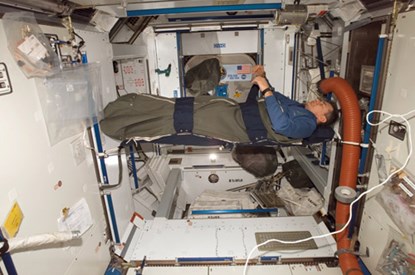Little things tear up when living in the universe
Floating life at a height of 420 km above the Earth's surface is a memorable experience in life. However, this is a difficult environment for astronauts to adapt, even from the most common activities.
>> With the astronaut hovering over the universe
The astronauts' difficulties when living on the universe
In 2011, Ron Garan had been living for 6 months on ISS. After returning, Garan a book recounts his life during this time and his experiences changed his outlook on life.

Astronauts sleep on ISS.(Photo: NASA)
No gravitation
At an altitude of 60 m in the sky, NASA built a structure connected to the shuttle to send astronauts to ISS. Above the door is a sign with the words: " The last shower on Earth ". Going through this door, Garan officially entered a new life.
The first hours in space, Garan felt nauseous.Astronauts are trained to become familiar with the zero gravity environment, but the training time of just a few hours is completely different from living in it 24 hours a day.
Garan described, the first minutes of experiencing a sense of weightlessness that were quite pleasant, but the astronauts would quickly vomit. His body seemed to be saying, " The zero gravity environment won't last that long. Something's not right here. "
At the end of the first day on ISS, Garan's body began to balance again and lost its nausea.
Sleep
On ISS, astronauts can't put their heads down and it makes it very difficult for them to sleep. The first night at the space station, Garan and his colleagues tied themselves to the floor, the wall or the floor with a sleeping bag . They could not put their heads on the pillows, because the pillows would also float in the compartment.
It took several weeks for Garan to adapt to the strange sleeping posture. Canadian astronaut Chris Hadfield shared the difficulties of going to bed in a different environment than Earth. On ISS, the cycle of day and night is different. The space station turns around Earth's orbit every 90 minutes, so every 45 minutes, astronauts will see the sunrise or sunset.
Time
In space, astronauts do not track the days of the week but instead are flying days (FD) . The first day Garan set foot on ISS is called FD1, the next day is called FD2.

Astronauts on ISS.(Photo: spacefellowship.com)
The two American astronauts Barry Wilmore and Terry Virts said they counted and welcomed the New Year 16 times, because the space station moved through an area of the Earth 16 times that night.
Body fluids
In space, you cannot cry either . Tears will still form, but not fall down but round like sticky balls.
Using the bathroom is a challenge when staying on ISS. Liquid and solid waste from sucked body to toilet to avoid floating in living space. Urine is processed into drinking water, while manure is transferred to an unmanned ship and burned when it returns to Earth.
Using a shower will damage the equipment on the cabin. Therefore, astronauts must use sponge bath to clean the body.
Vision
Cupola is the name for a dome window on ISS, the favorite location of many astronauts. From here, they can observe the aurora, look at the lights and the sparkling cities at night.
Garan believes that life on IS has completely changed his views and views on life. From a far distance and looking at Earth, he realized that nothing was impossible.
- The things you do every day will become very 'weird' when you are in the universe
- Do living objects and non-living objects follow the same rules?
- 22 billion years more Earth will explode?
- 12 hottest things in the universe
- How long can man live in the universe?
- The 10 strangest things of the universe
- Can life really exist in the 2D universe?
- 12 horrible things about China you may not know
- This swirling trail may be a trace of a dead universe that exists before the universe we know
- 6 common anecdotes about the universe far from reality
- What are the ancestors of all living things?
- 10 unknown things about life in the universe
 'Fine laughs' - Scary and painful torture in ancient times
'Fine laughs' - Scary and painful torture in ancient times The sequence of numbers 142857 of the Egyptian pyramids is known as the strangest number in the world - Why?
The sequence of numbers 142857 of the Egyptian pyramids is known as the strangest number in the world - Why? History of the iron
History of the iron What is alum?
What is alum?